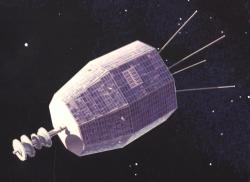On 23 November 1963, this site received the first transpacific transmission of a TV signal from Mojave earth station in California, U.S.A., via the Relay 1 communications satellite. The Ibaraki earth station used a 20m Cassegrain antenna, the first use of this type of antenna for commercial telecommunications. This event demonstrated the capability and impact of satellite communications and helped open a new era of intercontinental live TV programming relayed via satellite.
Antennae

YearAdded:
Image Credit:
Image Caption:
Artist's vision of NASA Relay 1 satellite
Era_date_from:
1963
2009

Beginning in 1924, Professor Hidetsugu Yagi and his assistant, Shintaro Uda, designed and constructed a sensitive and highly-directional antenna using closely-coupled parasitic elements. The antenna, which is effective in the higher-frequency ranges, has been important for radar, television, and amateur radio.
The antenna system, using a driven element with closely coupled parasitics (usually a reflector and one or more directors) for short-wave work, was first described by S. Uda, a professor at Tohuku University in Japan, in 1926, in the IEEJ (Japan). A colleague, Professor H.
YearAdded:
Image Credit:
Courtesy IEEE
Image Caption:
The Yagi-Uda directive short wave antenna
Era_date_from:
1924
1995

Dr. Takeshi Takei, the professor at the Tokyo Institute of Technology, discovered that composite oxides containing zinc and iron have distinguished magnetic properties. In 1930, Prof. Takei submitted a paper on his work to Japanese Electro-chemical Society and also presented a paper at 57th General Meeting of American Electrochemical Society in St. Louis. That same year, Prof. Takei applied a patent for his discovery, which was granted in 1932(Japan PAT-98844).
Tokyo Denki Kagaku Kogyo (now TDK Corporation) was founded in 1935 to commercialize this newly invented ferrite cores.
YearAdded:
Image Credit:
Courtesy Tokyo Institute of Technology
Image Caption:
A replica of the early soft-ferrite core.
Era_date_from:
1930
2009

Dr. Takeshi Takei, the professor at the Tokyo Institute of Technology, discovered that composite oxides containing zinc and iron have distinguished magnetic properties. In 1930, Prof. Takei submitted a paper on his work to Japanese Electro-chemical Society and also presented a paper at 57th General… Read More

Beginning in 1924, Professor Hidetsugu Yagi and his assistant, Shintaro Uda, designed and constructed a sensitive and highly-directional antenna using closely-coupled parasitic elements. The antenna, which is effective in the higher-frequency ranges, has been important for radar, television, and… Read More

On 23 November 1963, this site received the first transpacific transmission of a TV signal from Mojave earth station in California, U.S.A., via the Relay 1 communications satellite. The Ibaraki earth station used a 20m Cassegrain antenna, the first use of this type of antenna for commercial…
Read More

